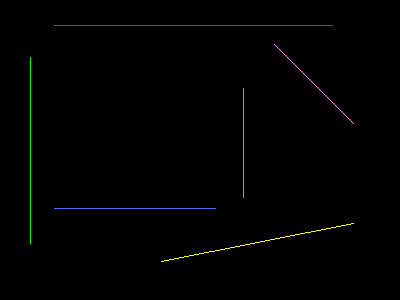|
|
HoughLine Class |
Hough line.
SystemObject
Accord.ImagingHoughLine
Accord.ImagingHoughLine
Namespace: Accord.Imaging
Assembly: Accord.Imaging (in Accord.Imaging.dll) Version: 3.8.0
The HoughLine type exposes the following members.
| Name | Description | |
|---|---|---|
| CompareTo |
Compare the object with another instance of this class.
| |
| Draw |
Draws the line to a given image.
| |
| Equals | Determines whether the specified object is equal to the current object. (Inherited from Object.) | |
| Finalize | Allows an object to try to free resources and perform other cleanup operations before it is reclaimed by garbage collection. (Inherited from Object.) | |
| GetHashCode | Serves as the default hash function. (Inherited from Object.) | |
| GetType | Gets the Type of the current instance. (Inherited from Object.) | |
| MemberwiseClone | Creates a shallow copy of the current Object. (Inherited from Object.) | |
| ToString |
Returns a String that represents this instance.
(Overrides ObjectToString.) |
| Name | Description | |
|---|---|---|
| Intensity |
Line's absolute intensity, (0, +∞).
| |
| Radius |
Line's distance from image center, (−∞, +∞).
| |
| RelativeIntensity |
Line's relative intensity, (0, 1].
| |
| Theta |
Line's slope - angle between polar axis and line's radius (normal going
from pole to the line). Measured in degrees, [0, 180).
|
| Name | Description | |
|---|---|---|
| HasMethod |
Checks whether an object implements a method with the given name.
(Defined by ExtensionMethods.) | |
| IsEqual |
Compares two objects for equality, performing an elementwise
comparison if the elements are vectors or matrices.
(Defined by Matrix.) | |
| To(Type) | Overloaded.
Converts an object into another type, irrespective of whether
the conversion can be done at compile time or not. This can be
used to convert generic types to numeric types during runtime.
(Defined by ExtensionMethods.) | |
| ToT | Overloaded.
Converts an object into another type, irrespective of whether
the conversion can be done at compile time or not. This can be
used to convert generic types to numeric types during runtime.
(Defined by ExtensionMethods.) |
Represents line of Hough Line transformation using polar coordinates. See Wikipedia for information on how to convert polar coordinates to Cartesian coordinates.
| Hough Line transformation does not provide information about lines start and end points, only slope and distance from image's center. Using only provided information it is not possible to draw the detected line as it exactly appears on the source image. But it is possible to draw a line through the entire image, which contains the source line (see sample code below). |
HoughLineTransformation lineTransform = new HoughLineTransformation(); // apply Hough line transofrm lineTransform.ProcessImage(sourceImage); Bitmap houghLineImage = lineTransform.ToBitmap(); // get lines using relative intensity HoughLine[] lines = lineTransform.GetLinesByRelativeIntensity(0.5); foreach (HoughLine line in lines) { // get line's radius and theta values int r = line.Radius; double t = line.Theta; // check if line is in lower part of the image if (r < 0) { t += 180; r = -r; } // convert degrees to radians t = (t / 180) * Math.PI; // get image centers (all coordinate are measured relative to center) int w2 = image.Width / 2; int h2 = image.Height / 2; double x0 = 0, x1 = 0, y0 = 0, y1 = 0; if (line.Theta != 0) { // non-vertical line x0 = -w2; // most left point x1 = w2; // most right point // calculate corresponding y values y0 = (-Math.Cos(t) * x0 + r) / Math.Sin(t); y1 = (-Math.Cos(t) * x1 + r) / Math.Sin(t); } else { // vertical line x0 = line.Radius; x1 = line.Radius; y0 = h2; y1 = -h2; } // draw line on the image Drawing.Line(sourceData, new IntPoint((int)x0 + w2, h2 - (int)y0), new IntPoint((int)x1 + w2, h2 - (int)y1), Color.Red); }
To clarify meaning of Radius and Theta values of detected Hough lines, let's take a look at the below sample image and corresponding values of radius and theta for the lines on the image:

Detected radius and theta values (color in corresponding colors):
- Theta = 90, R = 125, I = 249;
- Theta = 0, R = -170, I = 187 (converts to Theta = 180, R = 170);
- Theta = 90, R = -58, I = 163 (converts to Theta = 270, R = 58);
- Theta = 101, R = -101, I = 130 (converts to Theta = 281, R = 101);
- Theta = 0, R = 43, I = 112;
- Theta = 45, R = 127, I = 82.